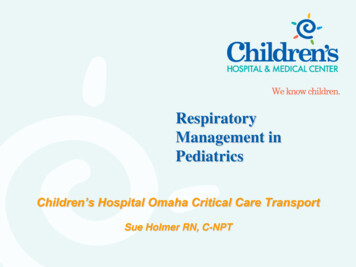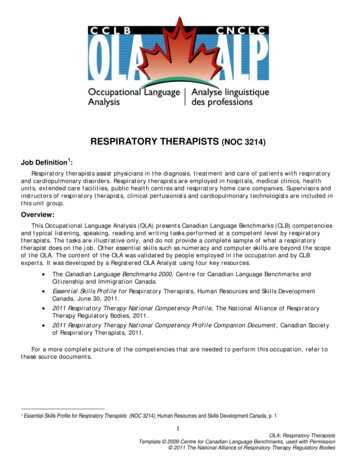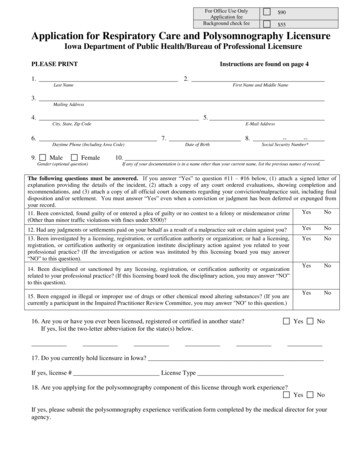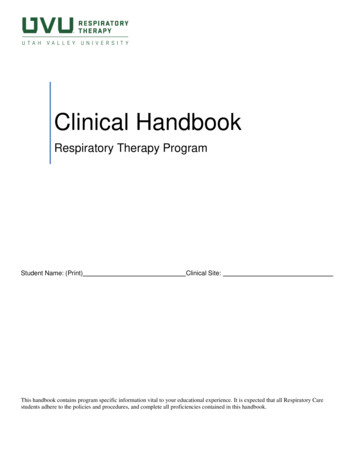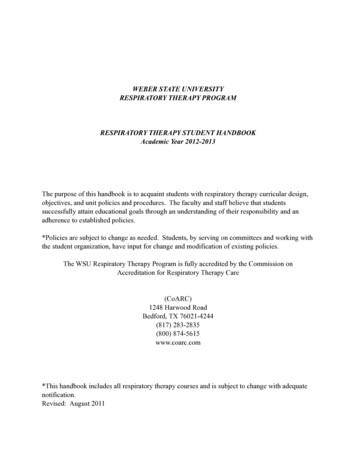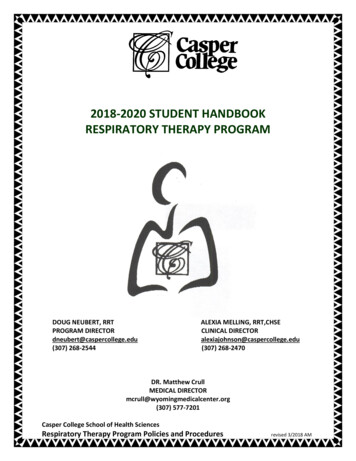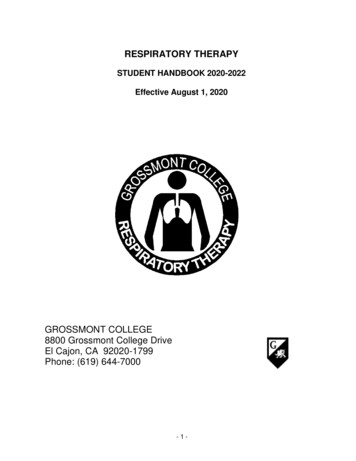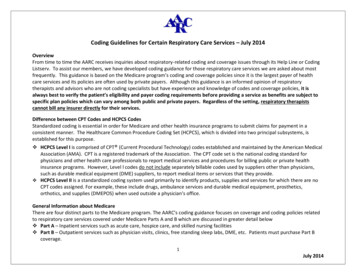
Transcription
Coding Guidelines for Certain Respiratory Care Services – July 2014OverviewFrom time to time the AARC receives inquiries about respiratory-related coding and coverage issues through its Help Line or CodingListserv. To assist our members, we have developed coding guidance for those respiratory care services we are asked about mostfrequently. This guidance is based on the Medicare program’s coding and coverage policies since it is the largest payer of healthcare services and its policies are often used by private payers. Although this guidance is an informed opinion of respiratorytherapists and advisors who are not coding specialists but have experience and knowledge of codes and coverage policies, it isalways best to verify the patient’s eligibility and payer coding requirements before providing a service as benefits are subject tospecific plan policies which can vary among both public and private payers. Regardless of the setting, respiratory therapistscannot bill any insurer directly for their services.Difference between CPT Codes and HCPCS CodesStandardized coding is essential in order for Medicare and other health insurance programs to submit claims for payment in aconsistent manner. The Healthcare Common Procedure Coding Set (HCPCS), which is divided into two principal subsystems, isestablished for this purpose. HCPCS Level I is comprised of CPT (Current Procedural Technology) codes established and maintained by the American MedicalAssociation (AMA). CPT is a registered trademark of the Association. The CPT code set is the national coding standard forphysicians and other health care professionals to report medical services and procedures for billing public or private healthinsurance programs. However, Level l codes do not include separately billable codes used by suppliers other than physicians,such as durable medical equipment (DME) suppliers, to report medical items or services that they provide. HCPCS Level II is a standardized coding system used primarily to identify products, supplies and services for which there are noCPT codes assigned. For example, these include drugs, ambulance services and durable medical equipment, prosthetics,orthotics, and supplies (DMEPOS) when used outside a physician’s office.General Information about MedicareThere are four distinct parts to the Medicare program. The AARC’s coding guidance focuses on coverage and coding policies relatedto respiratory care services covered under Medicare Parts A and B which are discussed in greater detail below Part A – Inpatient services such as acute care, hospice care, and skilled nursing facilities Part B – Outpatient services such as physician visits, clinics, free standing sleep labs, DME, etc. Patients must purchase Part Bcoverage.1July 2014
Part C – Medicare Advantage (i.e., managed care) Part D – Prescription drug coverageInpatient Hospital Reporting of Actual Services under Medicare Part AHospitals are paid under a prospective payment system in which items and services provided to hospital inpatients are categorizedinto a diagnosis-related group (DRG) regardless of the number of conditions treated or services provided. The payment rate for eachDRG is based on the average resources used to treat Medicare patients in that DRG. Codes for individual services provided during aninpatient hospital stay are not separately billed but are maintained in the facility’s finance department. For respiratory care services,these codes are used often to measure volume of work or productivity.Payment of Outpatient Hospital Services under Medicare Part BHospitals provide two distinct types of services to outpatients: services that are diagnostic in nature and other services that aid thephysician in the treatment of the patient. With a few exceptions, all hospital outpatient departments are paid under an outpatientprospective payment system (OPPS), although there are some services that can be paid under a fee schedule. While inpatientservices are paid under the DRG system as noted above, outpatient services are bundled into what are called Ambulatory PaymentClassification (APC) groups. Services within an APC are similar clinically and with respect to hospital resource use. Each HCPCS Codethat can be paid separately under OPPS is assigned to an APC group. The payment rate and coinsurance amount calculated for anAPC apply to all of the services assigned to the APC.Physician office or clinic-based services under Medicare Part BIn a physician office or clinic setting, respiratory therapy services are furnished “incident to” the care provided and ordered by aphysician (or placed in an approved protocol). Other professions, such as RNs and LPNs also provide services under the “incident to”Medicare provision. The physician bills Medicare directly as appropriate, not the RT.“Incident to” services are provided under the direct supervision of a physician and are of a type commonly furnished in a physician’soffice or clinic (not an institutional setting); an integral part of the patient’s treatment course; and commonly rendered withoutcharge (included in the physician’s bill). Medicare’s definition of “direct” supervision does not mean that the physician must bepresent in the room when the procedure is performed; however, the physician must be present in the office suite and immediatelyavailable to furnish assistance and direction throughout the performance of the procedure [emphasis added].Smoking Cessation CodesUnder current statutory and regulatory requirements, respiratory therapists can furnish smoking cessation counseling as “incidentto” a physician’s service under Medicare Part B (hospital outpatient or physician office). Only the physician or other qualified healthcare professional recognized by Medicare can bill Medicare directly for the service.2July 2014
Medicare covers smoking cessation counseling for those patients who smoke and have been diagnosed with a tobacco-relateddisease as well as those patients who smoke and are asymptomatic. In both instances, Medicare covers two individual smokingcessation counseling attempts per year. Each attempt may include a maximum of 4 intermediate OR intensive sessions, with thetotal benefit covering up to 8 sessions in a 12-month period. Minimal counseling is already covered at each evaluation andmanagement (E/M) visit (i.e., less than 3 minutes). These codes can be billed in addition to an E & M Code. Note: G codes are forasymptomatic patient counseling in the physician office setting; C codes are for asymptomatic patient counseling in the hospitaloutpatient setting. 99406 – Smoking and tobacco-use cessation counseling visit; intermediate, greater than 3 minutes up to 10 minutes. 99407 – Smoking and tobacco-use cessation counseling visit; intensive, greater than 10 minuteso Note – These codes are used for inpatient billing, approved by the finance department. Again, they are not paid butthe CPT code provided by RC is billed.(Do not report 99407 in conjunction with 99406) G0436 – Smoking and tobacco cessation counseling visit for the asymptomatic patient; intermediate, greater than 3 minutes, upto 10 minutes G0437 – Smoking and tobacco cessation counseling visit for the asymptomatic patient; intensive, greater than 10 minutes(Physician Office/Clinic) C9801 – Smoking and tobacco cessation counseling visit for the asymptomatic patient; intermediate, greater than 3 minutes, upto 10 minutes C9802 -- Smoking and tobacco cessation counseling visit for the asymptomatic patient; intensive, greater than 10 minutes(Hospital Outpatient Setting)Inhaler TechniquesThe following code is appropriate for inhaler techniques and can include demonstration of flow-operated inhaled devices such asflutter valves. The code may only be used once per day. This cannot be billed at the same time/ same visit as 94640. These can bebilled on the same day, but must be a separate patient visit. 94664 – Demonstration and/or evaluation of patient utilization of an aerosol generator, nebulizer, metered dose inhaler or IPPBdevice can be used demonstrating (teaching) patients to use an aerosol generating device property.Self-Management Education and Training Services (including Asthma)Self-management education and training services are not separately billable codes under Medicare and are not paid by Medicarewhen submitted for any outpatient bill type (e.g., hospital outpatient, physician office). If the service is covered, payment for itwould be bundled into the payment for other services for which the patient is being treated. This would be true in the inpatientsetting as well where services are paid under the assigned DRG. However, certain private plans may not necessarily follow Medicare3July 2014
with respect to this issue and may cover these services. In any event, in order for these codes to be reported, the CPT coding guidesets out the following requirements. Prescribed by a physician or other qualified health care professional Provided by a qualified, non-physician healthcare professional (i.e., nurse practitioner, physician assistant) Must use a standardized curriculum Qualifications of non-physician healthcare professionals and content of education/training programs are consistent witho Established guidelines or standards, ORo Recognized by a national professional society, ORo Other appropriate sources 98960 – Education and training for patient self-management by a qualified, non-physician health care professional using astandardized curriculum, face-to-face with the patient (can include caregiver/family) each session 30 minutes: individual patient. 98961 – 2 – 4 patients 98962 – 5 – 8 patientsOffice SpirometryPhysician office-based spirometry is covered if it meets the criteria stated in the code below, produces a tracing, and measures allthe elements mentioned. 94010 – Spirometry, including graphic tracing, total and timed vital capacity, expiratory flow rate measurement(s), with orwithout maximal voluntary ventilationPeak Flow MeterA peak flow meter is covered as a supply when furnished in the physician office setting for home use by the patient. HCPCS A4614 – Peak expiratory flow rate meter, hand heldPeak Flow Measurement TestThere is no code to identify this service at this timeInhalation Treatment for Acute Airway ObstructionWhen providing inhalation treatment for acute airway obstruction, Medicare will not pay for both 94640 and 94644 or 94645 if theyare billed on the same day for the same patient. The coder must decide which of the two codes to submit for payment. Generally, itwould be the code that has the greatest volume/quantity. As of January 1, 2014, the following information applies to inhalationtreatments administered to Part B patients. This includes Emergency Room patients who are not admitted to the hospital. CPT code94640 should only be reported once during a single patient encounter regardless of the number of separate inhalation treatmentsthat are administered at that time. However, if there are multiple separate patient encounters for inhalation therapy on the same4July 2014
date of service, the additional encounters for inhalation therapy may be reported with modifier 76. Medicare defines a hospitaloutpatient encounter as “a direct personal contact between a patient and a physician, or other person who is authorized by Statelicensure law and, if applicable, by hospital or CAH staff bylaws, to order or furnish hospital services for diagnosis or treatment of thepatient.” 94640 – Pressurized or non-pressurized inhalation treatment for acute airway obstruction or for sputum induction for diagnosticpurposes (e.g., with an aerosol generator, nebulizer, metered dose inhaler or intermittent positive pressure breathing [IPPB]device) 94644 – Continuous inhalation treatment with aerosol medication for acute airway obstruction; first hour(For services of less than 1 hour, use 94640) 94645 – each additional hour (List separately in addition to code for primary procedure)(Use 94645 in conjunction with 94644)Ventilators Used in the Emergency Department (ED)Unfortunately, there is no CPT code for ventilators used in the Emergency Department (ED). This includes instances where a patientexpires in the ED or is transferred to another facility. However, if the patient in the ED is admitted as a hospital inpatient in the samefacility, the following code may be used for the ventilator. 94002 – Ventilation assist and management, initiation of pressure or volume preset ventilators for assisted or controlledbreathing, hospital inpatient/observation, initial dayPulmonary RehabilitationMedicare covers pulmonary rehabilitation (PR) programs (i.e., those consisting of components set forth in law) for patients whohave been diagnosed with moderate, severe, or very severe COPD as established by the GOLD guidelines. No more than two onehour sessions may be billed in a single day and the services are only covered if provided in a physician’s office or hospital outpatientdepartment. Individual components of the comprehensive PR program can be provided by one or more members of the multidisciplinary team, which includes RTs, but none of those services are separately billable under the PR benefit. The individual servicesfurnished prior to the PR benefit are now bundled into a single HCPCS code as described below. (See Frequently Asked Questions formembers only at http://www.aarc.org/resources/pulmonary rehab/ for additional information). G0424 - Pulmonary rehabilitation, including aerobic exercise (includes monitoring), per session, per dayIf a patient does not meet the COPD criteria above, their services can be covered as individual respiratory care services (notpulmonary rehabilitation). Medicare contractors have established local coverage determinations (LCD) for this subset of patients. Inthe absence of a LCD, contractors can pay claims on a cases-by-case basis as long as the service is deemed medically necessary.G0424 should not be used in billing services for non-COPD patients.5July 2014
G0237 – Therapeutic procedures to increase strength or endurance or respiratory muscles, face to face, one on one, each 15minutes (includes monitoring) G0238 – Therapeutic procedures to improve respiratory function, other than described by G0237, one on one, face to face, per15 minutes (includes monitoring) G0239 – Therapeutic procedures to improve respiratory function or increase strength or endurance or respiratory muscles, twoor more individuals (includes monitoring)Six-Minute Walk TestIt is appropriate to use the six-minute walk test code to evaluate distance, dyspnea, oxyhemoglobin desaturation, and heart rate.Heart rate, blood pressure, oxygen saturation, and liter flow of supplemental oxygen are to be reported at rest, during exercise, andduring recovery. Physician analysis of data and interpretation of the test are procedurally inclusive components of this code. 94620 – Pulmonary stress testing; simple (e.g., 6-minute walk test prolonged exercise test for bronchospasm with pre- and postspirometry and oximetry)Pulmonary Function TestingIn 2012, there were significant changes to the CPT codes for pulmonary function testing. Ten codes were deleted and four newcodes were established. Below is a breakdown of the changes. Where codes have been deleted, the current code used to report theservice is provided:Deleted Codes: 93720-93722 – Plethysmograpy (To report, see 94726) 94240 – Residual Lung Capacity (To report, see 94726, 94727) 94260 – Thoracic Gas Volume (To report, see 94726, 94727) 94350 – Lung Nitrogen Washout Curve (To report, see 94727) 94360 – Measure Airflow Resistance (To report, see 94726, 94728) 94370 – Breathe Airway Closing Volume (To report, see 94727) 94720, 94725 – Diffusing Capacity (To report, see 94729)Current Codes: 94726 – Plethysmography for determination of lung volumes and, when performed, airway resistance(Do not report 94726 in conjunction with 94727, 94728) 94727 – Gas dilution or washout for determination of lung volumes and, when performed, distribution of ventilation and closingvolumes(Do not report 94727 in conjunction with 94726) 94728 – Airway resistance by impulse oscillometry(Do not report 94728 in conjunction with 94010, 94060, 94070, 94375, 94726)6July 2014
94729 – Diffusing capacity (e.g., carbon monoxide, membrane) (List separately in addition to code for primary procedure)(Report 94729 in conjunction with 94010, 94060, 94070, 94375, 94726-94728)Mechanical Chest Wall OscillationEffective January 1, 2014, a new code has been established to identify the application of and training for a device to accomplishmechanical high-frequency chest wall oscillation (HFCWC) such as a HFCWC Vest. The AARC, together with the American College ofChest Physicians (ACCP) and the American Thoracic Society (ATS) worked for 3 years with the AMA to get this code approved inresponse to requests from respiratory therapists. The code is reported per session and identifies applying the device for use and/ortraining provided by the health care professional for independent patient use. New AMA guidelines have been added to explain thetwo methods of accomplishing chest well manipulation (manual (94667, 94668) or mechanical (94669). 94669 – Mechanical chest wall oscillation to facility lung function, per sessionMiscellaneous CodesBelow are codes that were approved by the AMA’s CPT Editorial Panel and became effective January 1, 2012. 94728 – Airway resistance by impulse oscillometry(Do not report 94728 in conjunction with 94010, 94060, 94070, 94375, 94726) 94780 – Car seat/bed testing for airway integrity, neonate, with continual nursing observation and continuous recording of pulseoximetry, heart rate and respiratory rate, with interpretation and report; 60 minutes(Do not report 94780 for less than 60 minutes)(Do not report 94780 in conjunction with 94010, 94060, 94070, 94375, 94726) 94781 – each additional full 30 minutes (List separately in addition to code for primary procedure7July 2014
Coding Guidelines for Certain Respiratory Care Services - July 2014 Overview From time to time the AARC receives inquiries about respiratory-related coding and coverage issues through its Help Line or Coding Listserv. To assist our members, we have developed coding guidance for those respiratory care services we are asked about most frequently.


